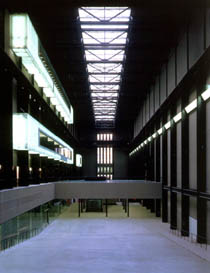
The London gallery Tate Modern offers a completely new installation
 |
The curators concentrated the new installation around four "turning points" in 20th-century art, assigning them to four main halls spread across two floors of the vast building of the gallery. Surrounding them are exhibitions related to authors or movements in time, space, or artistic thought.
These secondary exhibitions will change slightly every six months. This is intended to create dynamics, conflict, and dialogue in the gallery and avoid gradual ossification.
The four pivotal moments - cubism, surrealism, abstract expressionism, and minimalism - were chosen by the gallery not only for their importance to the art of the last century but also because they are best represented in its collections. A special hall is dedicated to art after 2000, and the gallery is now, according to Serota, focusing on regions outside of Northwest Europe and North America, now including Central and Eastern Europe as well.
Experts, connoisseurs, and students of modern art will be able to see iconic paintings for the first time in the halls, such as Wham! by Roy Lichtenstein or the entire red and black series Seagram Murals by Mark Rothko. Essential works by Max Ernst, George Braque, Robert Delaunay, Marcel Duchamp, Piet Mondrian, Salvador Dalí, Pablo Picasso, Andy Warhol, and other artists are also included.
Tate Modern is a successor to the Tate gallery. In 2000, it opened as its new headquarters in a former power station on the banks of the Thames opposite St. Paul's Cathedral. Since then, it has been visited by about 26 million visitors. In addition to the quality of its collections, the gallery's attendance is supported by the fact that it, like other major museums in Britain, is fully funded by public resources and sponsors and does not charge admission fees.
The English translation is powered by AI tool. Switch to Czech to view the original text source.











